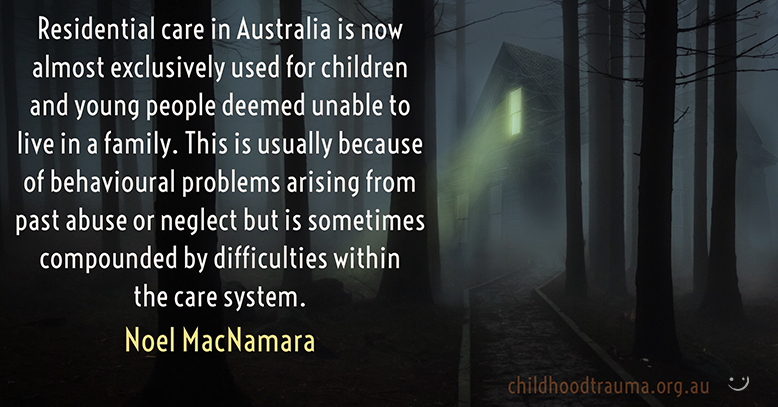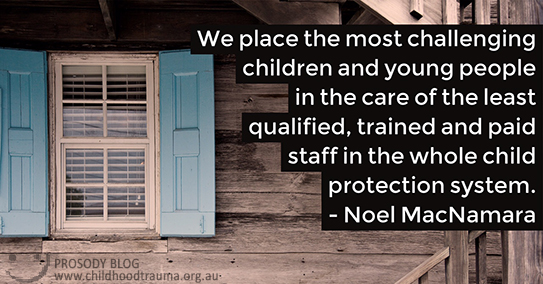
Residential Care in Australia

This blog entry was authored by Noel MacNamara,
National Manager, Research and Policy at the Australian Childhood Foundation.
There has been ongoing concern about the safety and quality of children’s experiences in Australia’s residential care systems for a very long time. The ABC Four Corners program that aired this week (‘Broken Homes‘, 14/11/16) is another example of the concerns that have been expressed by many. We heard again about the lack of safety experienced by the young people and the failures in the system to support staff. The program raised many questions about child protection systems in Australia. This blog reflects on some of those questions.
Residential Care
Residential care is one part of a complex system of alternative care for abused and neglected children. Recent decades have seen an overall decline in the use of residential care for children and young people in Australia. This has occurred within the wider context of de-institutionalisation but also because of concerns about the lack of attachment in young children and the risk of abuse. Australia now has the lowest rate of residential care in in the developed world (Ainsworth and Hansen, 2005).
In the context of a system of out of home care now dominated by both kinship care and foster care as the options of preference, intractable problems within residential care services continue to be reported. Commenting on the situation in Australia, Ainsworth and Hansen (2005) suggest that:
“The dream – no more residential care – has gone disastrously wrong. One consequence of the attempt to do without residential care programmes rather than transform them into residential education and treatment facilities is that there is a crisis in foster care in NSW and every other Australian State and Territory.” (p. 197).
A number of major reports on out-of-home care in Australia have, in recent years, stressed that the provision of home-based care is in a state of crisis, and conclude that urgent reform in a number of areas is required (Barber and Delfabbro, 2004; Bromfield et al., 2005; Carter, 2004; CSCAC, 2005; QCMC, 2004).  Residential care in Australia is now almost exclusively used for children and young people deemed unable to live in a family. This is usually because of behavioural problems arising from past abuse or neglect but is sometimes compounded by difficulties within the care system. The depth of the challenges that children and young people in residential care in Australia face are daunting: Bath (2009) cited: attachment disorders; an impaired ability to trust; trauma-related symptoms; education problems; intellectual disability; neuro-developmental problems; mental illness and aggression. Ainsworth and Hanson (2005) go on to say:
Residential care in Australia is now almost exclusively used for children and young people deemed unable to live in a family. This is usually because of behavioural problems arising from past abuse or neglect but is sometimes compounded by difficulties within the care system. The depth of the challenges that children and young people in residential care in Australia face are daunting: Bath (2009) cited: attachment disorders; an impaired ability to trust; trauma-related symptoms; education problems; intellectual disability; neuro-developmental problems; mental illness and aggression. Ainsworth and Hanson (2005) go on to say:
“These children and young people invariably demonstrate an inability to live peaceably with others, either their immediate family or foster carers. They rarely attend day school as they have usually been suspended or expelled. A history of multiple disrupted foster care placements is commonplace. They are so alienated from others that without effective intervention to steer them to an alternative outcome they face long-term unemployment and homelessness, with the potential to drift into a life of social isolation, adult crime and poverty”.
These characteristics were well described by the young people and ex-staff members in the Four Corners program.
Overall we appear to be very confused about what the purpose of residential care we have is within a developed child welfare system. Is it to be a:
- Last resort?
- Temporary refuge for children and young people until a better alternative is found?
- Home where children can be brought up as an alternative to family life?
- Therapeutic setting where children receive treatment for problems caused by adverse childhood experiences?
Residential care in Australia seems to be largely defined by what it is not, that is: it does not have a clear purpose; the service delivery is not guided by a theoretical underpinning; it is not evidence based and outcome focused; it is not staffed by well-qualified professionals who receive adequate training and support. Children and young people in this type of care are not placed there based on a robust assessment of their needs and the kind of placement that can effectively meet these needs; they are typically placed in residential care as usual because everything else has failed. They know this; the staff who care for them know this and the system that placed them there know this.
No type of residential placement, however well-conceived, will work unless day-to-day practice is of the highest quality. Formal programs and intervention methodologies are important, but even more important are the people who are delivering them. Whilst specialist and therapeutic placements are needed, all staff should be able to develop relationships with the children and young people they care for based on an understanding  of what will help them to deal with abuse, loss and trauma. It was in relationships (dysfunctional) that the abuse happened to these children and it is within (healthy) relationships that recovery will happen. Whenever children or young people are asked (as evidenced in the ABC Four Corners program), they say it is the staff who make the difference. This is not reflected in the status, pay or training that residential care staff in Australia receive. We place the most challenging children and young people in the care of the least qualified, trained and paid staff in the whole child protection system.
of what will help them to deal with abuse, loss and trauma. It was in relationships (dysfunctional) that the abuse happened to these children and it is within (healthy) relationships that recovery will happen. Whenever children or young people are asked (as evidenced in the ABC Four Corners program), they say it is the staff who make the difference. This is not reflected in the status, pay or training that residential care staff in Australia receive. We place the most challenging children and young people in the care of the least qualified, trained and paid staff in the whole child protection system.
These Young People are Known to Us
The majority of children and young people who live in residential care have been known by the child protection system since their first year of life (this was true of the two young people who spoke on the Four Corners program both had been known since birth). Why is it that a child can spend all of their life in a system and remain untreated for the reasons they entered the system: abuse, neglect and trauma? We are also highly aware that many of their foster care placements are most vulnerable at the point of adolescence, however we fail to intervene or support appropriately.
The Way Forward?
There is now a wealth of literature indicating what practice and care that promotes healing should include (Bloom & Farragher, 2011). What follows are the six environmental conditions required for health and growth, in an individual, a foster family, kinship care or a residential setting:
1. Safety
2. Belonging
3. Consistency/Predictability
4. Opportunity
5. Acceptance
6. Hope
These are a minimum requirement for any placement for children. We must build a placement system with these principles as the central unifying processes.
Conclusion
Rather than eliminating residential care, what needs to be eliminated is ‘bad’ practice. That is: bad decision making, failure to properly assess children’s needs, poor training, lack of support. Residential services should be reconfigured so that they can effectively meet the needs of children and young people who, for a range of reasons, need a residential placement; while at the same time we need to improve the way we help children and young people who have experienced traumatic events in their childhoods. We must also provide the right level and type of support to those who care for these children and young people (foster and kinship and residential carers).
The challenge for any child protection system is to develop a continuum of services that can meet each child and young person’s assessed needs at the earliest point, whether in a foster family, kinship care or a residential setting. It must not be:
“We found that children are poorly matched to placements and placement decisions are often based on where there is an available bed, rather than on the needs of the child”.
“…as a good parent would…” 2015
There is also a significant gap in provision for children and young people with challenges that require more than a therapeutic milieu. The Child Commissioner in Victoria found in 2015 that:
“We found that there are no specialist residential care services for children with particular vulnerabilities and complex Needs”.
“…as a good parent would…” 2015
The idea of a continuum also needs to extend to the way services are delivered, we must reduce the barriers between types of setting, increase family involvement and ensure more continuity in interventions before, during and after placement. Also, every child and young person in the out of home care system requires an effective Care Team around them and those who care for them.
Without a comprehensive review of the overall systems of out of home care we merely push the problem from one place to another and we wait for another report into the failures of the care of the most vulnerable children and young people in society.
